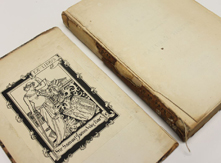Adopt-a-Book
An Initiative of the Friends of the University of Adelaide Library
Tracts relating to natural history.
James Edward Smith (1759-1828)
London: Printed for the author, by J. Davis, 1798
Rare Books & Special Collections
Rare Books Collection RB 580.4 S65
We thank our donor...
Tracts relating to natural history was generously funded by Adopt-a-book donor, Barbara Kidman. Her valued contribution has ensured this important volume on natural history, with its botanical papers, will be available for future generations of researchers for many years to come.
Synopsis
Comprising twelve papers and seven hand-coloured plates, Tracts relating to natural history is one of many independent works authored by English botanist, James Edward Smith. It includes reprinted articles, with corrections, originally written for publications such as the Analytical review. It also incorporates early papers never before translated into English and a couple never previously published, essentially showcasing the cultivation of Smith’s natural history knowledge over his lifetime.
Sir James Edward Smith was born at Norwich in 1759. The eldest child of wealthy wool merchant, James Smith, and his wife Francis, Smith was first educated at home, where he developed an early interest in flowers. He did not study botany, however, until the age of eighteen when he enrolled in medicine at Edinburgh University – the only course to offer botany lectures at the time. A diligent student, Smith was awarded a gold medal by his professor, Dr. John Hope, one of the earliest teachers of the Linnaean method. He also formed, with his friends, a natural history society which established a collection of native Scottish plants.
In 1783 Smith moved to London to continue his medical studies under John Hunter and William Pitcairn, with an introduction from Dr. Hope to Sir Joseph Banks. One morning in December that year, Banks was having breakfast with Smith when a letter arrived announcing the death of Carl Linnaeus (the younger), son of the famous Swedish botanist, zoologist and physician who formalised the modern system of naming organisms - ‘binomial nomenclature’. The letter offered to Banks Linnaeus’s entire botanical collection, library, manuscripts and correspondence. Banks declined the offer but advised Smith to make the purchase, for which the latter obtained his father’s funding a few months later.
The purchase represented a pivotal chapter for natural history. The substantial collections were shipped to England, where they provided the material and basis for advancement of the Linnaean system in Britain. They also led to Smith’s founding of the Linnean Society of London which today plays a central role in the documentation of the world’s flora and fauna, providing a forum for those who study and work in all aspects of the biological sciences. The purchase of Linnaeus’s collection, comprising some 3,000 books, manuscripts, plants, minerals and insects, for 1,000 guineas, was significant for Smith. Publicity surrounding the collection brought with it a certain regard for Smith from the scientific community, and he was elected a Fellow of the Royal Society in 1785.
Whilst President of the Linnean Society, Smith lectured on both botany and zoology and published several works, including English Botany: Or, Coloured Figures of British Plants (1790-1814); Icones pictae plantarum rariorum (Coloured pictures of rare plants)… (1790-1793) and Tentamen botanicum de filicum generibus dorsiferarum, one of the earliest scientific papers known to exist on fern taxonomy. In collaboration with illustrator James Sowerby, Smith also produced A specimen of the botany of New Holland (1793-1795), the first published book on Australian flora. His later works such as An Introduction to physiological and systematical botany (1807) and A grammar of botany (1821), introduced botany to a wide range of new audiences and were reprinted multiple times.
In 1814 Smith was honoured with a knighthood – a recognition of achievements that included the contribution of more than fifty papers to the Transactions of the Linnean Society. He continued to be re-elected as President of the Linnean Society until his death in 1828, and found time to pursue other causes dear to his heart, including the abolition of slavery and Greek independence.
Tracts relating to natural history contains twelve of Smith’s papers, including ‘Reflections on the study of nature’, ‘Discourse on the rise and progress of natural history’, ‘Observations on the irritability of vegetables’, ’Review of an early introduction to drawing flowers according to nature’ and ‘Description of a new genus of plants called Boronia’, to name just a few.
Original Condition
8vo half-calf binding with marbled paper boards. Front and rear boards, front endpaper and front free endpaper all detached. Leather severely rubbed, all edges chipped, corners bumped and most of the leather from spine missing. Requires rebacking. Some small tears to individual leaves.
 |
||
 |
Restoration by Anthony Zammit
Existing leather on spine removed. Unable to be reused due to severe degradation consistent with red rot. Item fully rebacked with new custom-dyed calfskin. New red, paper spine label with gilt lettering, sympathetic in style to the original, attached to the spine. Board corners consolidated and re-covered with new leather. Front and rear endpapers and fly-leaves reattached with Japanese repair paper. Inner joints and tears throughout the textblock also repaired and strengthened with Japanese paper.
 |
 |
|
 |
 |




